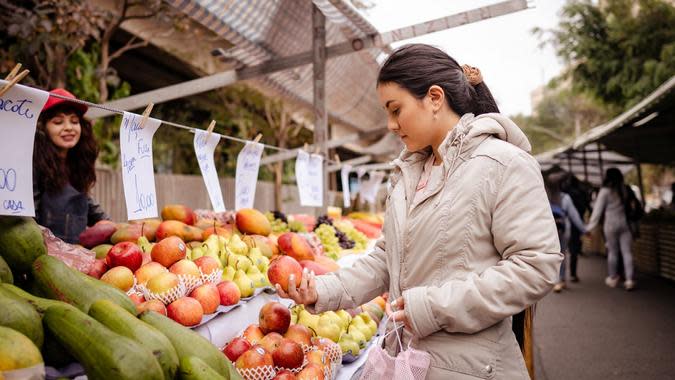7 Unconventional Ways To Save on Your Next Grocery Bill

Groceries are expensive, but you already know that. You’re not alone if traditional ways to spend less, such as clipping coupons and buying store-brand items, simply aren’t cutting it.
Following a moderate cost plan, the average price of food at home for men in the 19-to-50-year-old age group is $374.20 per month, according to the U.S. Department of Agriculture. Women in this age group, also following the same cost plan, spend approximately $315.50 per month on groceries.
For You: I’m a Shopping Expert: 9 Items I’d Never Put in My Grocery Cart
Read Next: How To Get $340 Per Year in Cash Back on Gas and Other Things You Already Buy
Thankfully, there are plenty of unconventional ways to lower your grocery bill while maintaining a healthy diet. If you’re willing to put in the work and change a few habits, you can quickly save a noticeable amount of money.
Now it’s time to get to work. Here’s a look at seven unconventional ways to spend less on groceries.

Master the Farmers Market
Blanca Garcia, a registered dietitian nutritionist at Health Canal, said she loves farmers markets, but they can be quite pricey. However, she noted that some have a matching system if you use an EBT card.
“You can reach out to a staff member at the participating farmers market, and they will match the amount of dollars you want to spend,” she said. “So if you want to spend $10 dollars, the staff member will give you an additional $10 to spend.”
The USDA maintains a list of farmers markets that participate in the Supplemental Nutrition Assistance Program. If you receive these benefits, check and see if any near you are on it.
She said there’s also another solution for people who don’t receive aid.
“Go to the farmers market at the last hour of the day,” she said. “Most farmers don’t want to take food back with them and will often bundle up the vegetables and place them on sale for deep discounts.”
If you do this often enough, she said you can create a great relationship with the vendors, serving as a win for everyone.
Check Out: 6 Things Minimalists Never Buy — and You Shouldn’t Either

Ask for Discounts on Fruits and Vegetables
If you think supermarket prices on fruits and vegetables are always firm, you may be mistaken, Garcia said. In some cases, there could be room for negotiation.
“The toughest part about buying on a budget is getting over the fear of hearing ‘no’,” she said. “Once you are over it, the possibilities open up.”
If grocery store workers are clearing out a section of produce to swap it with something different, they typically throw away the fruit or vegetable they’re removing, she said. When she’s seen this happening in the past, she’s stepped in to try to get a deal.
“I asked them if I could buy any of the produce they just took out and have a discount,” she said. “Most of the time, they say yes, take out a black marker, and write 50% off or something close to that.”

Take Advantage of Sales on Staple Foods
Paying attention to sales can offer big savings on your grocery bill.
“The idea is not to buy everything you see that is on sale,” Garcia said. “Only buy what is always used in your home.”
She said she personally uses this technique to cut costs.
“For example, sometimes the butter I buy is on sale, and as long as it is refrigerated, I buy the maximum amount allowed,” she said. “But if no one at home eats yogurt except for you, buying the maximum amount doesn’t make sense [as] you run the risk of it going bad.”

Look for Unwanted Foods
“Most grocery stores have ugly produce or food that is about to expire,” Garcia said. “These are often trays or stands hidden in the back.”
If you don’t care what the food looks like — and really, that isn’t what matters anyway — you can opt for these discounted items.
“Ugly produce can cut your costs significantly, and because they are ugly, you can use them in soups, casseroles and even smoothies,” she said. “If the produce looks like it’s in its last days, you can freeze it for up to three more months.”
Of course, she said you need to be mindful of expiration dates on these items.
“Food that is about to expire, although it can be scary for some, is actually quite safe to use,” she said. “I often always recommend that if you find a food that is about to expire, use it in the next meal you will be preparing.”

Commit to Meal Planning
“When cooking on a budget, the most important thing you can do is reduce food waste, and that begins with a meal plan,” said Andrea Woroch, a consumer and money-saving expert.
She said to look at your calendar for the week ahead to determine when you’ll be eating at home and when you’ll be dining out.
“Once you know your schedule, pick your family’s favorite meals and make it simple with themes like Taco Tuesday or Pizza Friday,” she said. “I also suggest looking for recipes that use overlapping ingredients to ensure you use up everything you buy in its entirety and nothing ends up in the trash.”
She suggested using meal-planning apps like to find easy and cost-effective recipes.

Take Pictures of Your Grocery Receipts
“Taking pictures of your grocery receipts may not be a conventional way to save, but it can earn you big bucks back for your food purchases,” Woroch said.
She recommended downloading the Fetch app.
“Upload pictures of your grocery receipts to start earning points, which can be redeemed for gift cards [at] a variety of stores including Target, Amazon, Walmart and Sam’s Club, which you can then use save on future grocery purchases,” she said. “Check their ‘special offers’ section to see which grocery stores or brands will get you more points to rack up those free gift card[s] faster.”
With a little strategic planning, she said you can collect free rewards quickly.

Be Selective on Bulk Purchases
“Most conventional grocery savings advice suggests you could save on food packages by grabbing the biggest box, but I’m actually telling you to rethink those bulk buys,” Woroch said.
If you buy too much food in bulk, some of it is bound to end up in the trash, she said.
“While bulk packages offer the best price per unit, you run the risk of some of it going bad before you’ve had a change to consume it all,” she said. “For instance, buying a few large bags of chips or crackers means some of it could get stale if you don’t eat it all right away, so now some of it ends up in the trash and any savings you repeated gets tossed at the same time.”
This article originally appeared on GOBankingRates.com: 7 Unconventional Ways To Save on Your Next Grocery Bill
